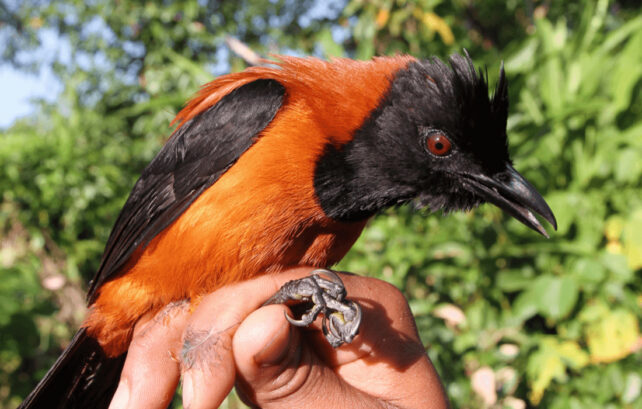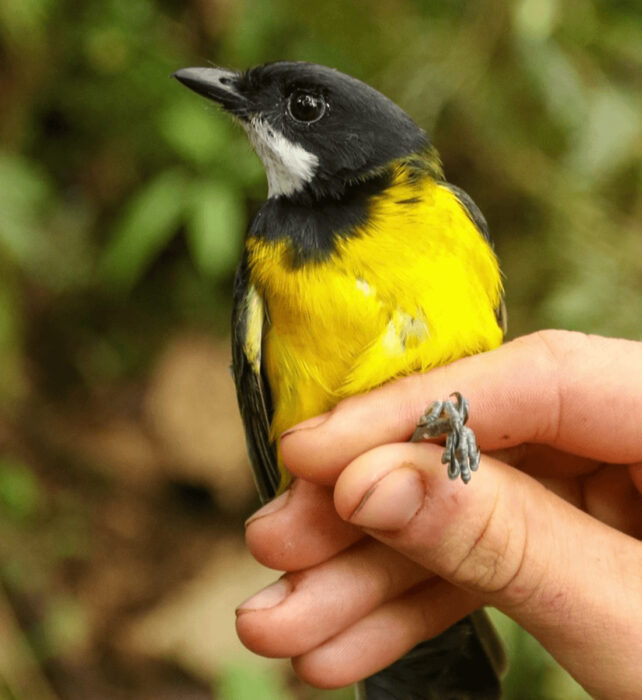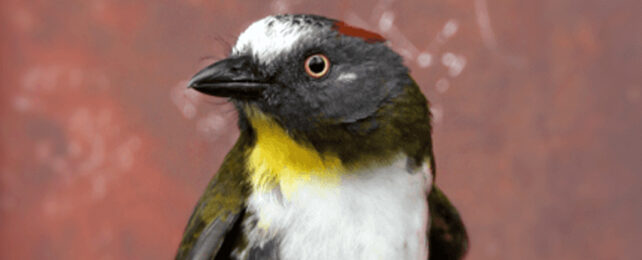Birds likely aren't the first things that spring to mind when you think of poisonous animals, but two common species in Papua New Guinea have been found hoarding a toxic arsenal in their feathers.
The regent whistler (Pachycephala schlegelii) and rufous-naped bellbird (Aleadryas rufinucha) have been caught in possession of a potent neurotoxin. Batrachotoxin causes muscle cramps and near-instantaneous cardiac failure on contact at high levels. The brightly colored birds store a metabolized version of the poison in their feathers, creating a nasty surprise for any predator that dares have a taste.
And researchers have just uncovered how these avians, as well as those species already known to be poisonous, avoid making themselves sick in the process.
Because ingesting Batrachotoxin can be fatal; even making mild contact with it is unpleasant, as the researchers found out.
"It's a bit like cutting onions – but with a nerve agent, I guess," says University of Copenhagen evolutionary ecologist Kasun Bodawatta, who ended up with a streaming nose and mouth while removing feather samples in a confined space from a hooded pitohui (Pitohui dichrous).
The medium-sized songbird with striking orange and black feathers was the first bird discovered hoarding this poison only 30 years ago.

While the pitohui's level of poison can vary geographically, it's one of the most poisonous known bird species. The toxin is suspected to be a deterrent for either predators or parasites or possibly a combination of both.
"The locals aren't fond of spicy food and steer clear of these birds because, according to them, their meat burns in the mouth like chili," explains evolutionary ecologist and biogeographer Knud Jønsson from the Natural History Museum of Denmark.
"In fact, that's how researchers first became aware of them. And the toxin can be felt when holding onto one of them. It feels kind of unpleasant, and hanging on to one for long isn't an appealing option. This could indicate that the poison serves them as a deterrence of those who would want to eat them to some degree."
The two species newly found to be toxic live along with the Pitohui in some of the world's most isolated jungles and have been found with Choresine beetle – which are packed with batrachotoxins – remains in their guts. But the exact source of their poison is yet to be confirmed.
"We were really surprised to find these birds to be poisonous as no new poisonous bird species has been discovered in over two decades," says Jønsson. "Particularly, because these two bird species are so common in this part of the world."

South America's poison dart frogs are notorious for oozing the same poison at higher concentrations from their skin, and they are known to feast on Choresine beetles. Inspired by these frogs, Bodawatta and colleagues delved into the bird's genetics to see if there were any similarities to their toxin tolerances.
The neurotoxin works "by forcing sodium channels in skeletal muscle tissue to remain open," and can cause violent convulsions and, ultimately, death, explains Bodawatta.
The team found that birds and frogs have mutations in a protein that forms one of the sodium channels. The mutations are in the same sodium channel coding gene SCN4A but in different locations within the gene. This is an example of convergent evolution, where natural selection has independently shaped other solutions with the same result in unrelated species.
The spread of poisonous organisms throughout an ecosystem is a slow-moving but fierce evolutionary battle. Prey species like insects and beetles develop poison to avoid being eaten, allowing them to venture into previously dangerous parts of their territories and exploit the resources there, but over long periods of time, predators – such as birds looking for a meal – develop cunning ways to overcome their prey's chemical weapons.
The bird species "acquires a mutation that offers resistance to the toxin. This gives the bird an advantage and opens up a whole new food source that isn't available to its ecosystem competitors. So, there is clearly an arms race going on and the beetles will need to crawl back under that rock again until they've developed their next move a few million years later," explains Jønsson.
"Subsequently, the birds that have evolved the ability to eat toxic food themselves become toxic and may be able to defend themselves against predators further up the food chain. And so, the race continues up the chain. It's evolution – anything can happen, but it often takes a long time."
This research was published in Molecular Ecology.
